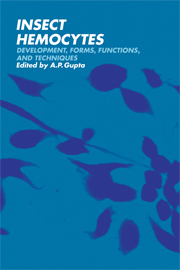Book contents
- Frontmatter
- Contents
- Preface
- List of contributors
- Part I Development and differentiation
- 1 Embryonic hemocytes: origin and development
- 2 Postembryonic development and differentiation: hemopoietic tissues and their functions in some insects
- 3 Multiplication of hemocytes
- Part II Forms and structure
- Part III Functions
- Part IV Techniques
- Indexes
1 - Embryonic hemocytes: origin and development
Published online by Cambridge University Press: 04 August 2010
- Frontmatter
- Contents
- Preface
- List of contributors
- Part I Development and differentiation
- 1 Embryonic hemocytes: origin and development
- 2 Postembryonic development and differentiation: hemopoietic tissues and their functions in some insects
- 3 Multiplication of hemocytes
- Part II Forms and structure
- Part III Functions
- Part IV Techniques
- Indexes
Summary
Introduction
Although embryonic hemocytes, or blood cells as previously termed, have been described in papers dealing with organogenesis, the available information is fragmentary. The origin of hemocytes has been more or less closely observed, but the cytological features of hemocytes have not been adequately described. Furthermore, the development of hemocytes has hardly been noted. Functions and activities of embryonic hemocytes have been neglected almost completely.
Perhaps the reason why insect embryologists have not given much attention to embryonic hemocytes is because the role of these free cells in embryogenesis is quite obscure. No direct participation of hemocytes in the formation of any of the embryonic organs seems to have been observed. Embryologists have been devoting much attention to the details of midgut epithelium formation, because this elucidates the mode of entoderm formation. The metameric segmentation of the embryos also has been closely followed to discover the number of segments in the insect head. However, the unique nature of the embryonic hemocytes seems to have completely escaped the attention of embryologists.
The embryonic hemocytes are unique among embryonic cells because these cells are single and may circulate in the embryo even during the final phase of embryogenesis; they may move by themselves or be moved by the hemolymph. As embryogenesis proceeds, morphogenetic movement of each cell becomes slow, and the topographical positions of various cells in the embryo become gradually fixed. For example, the drastic shift in the positions of cells seen at the stage of germ band formation seems to be lost when the embryo is very close to hatching.
- Type
- Chapter
- Information
- Insect HemocytesDevelopment, Forms, Functions and Techniques, pp. 3 - 28Publisher: Cambridge University PressPrint publication year: 1979
- 6
- Cited by

